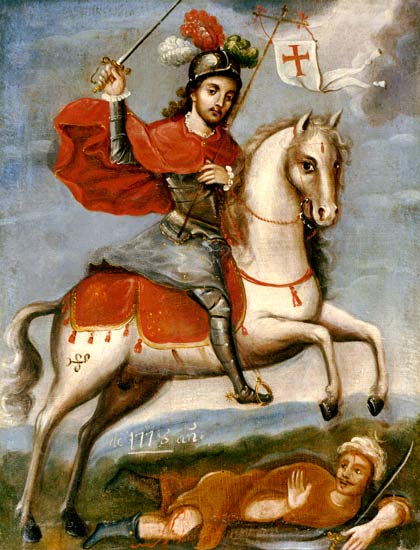 |
| A depiction of one of the battles. It shows just how... colourful and confusing the fighting was, I guess. |
Wikipedia, save my career.
In the early 700s the Moors, an Islamic group centred around North Africa, took over much of present day Spain and Portugal due to a lacking army of the then in power Visigoths. Supported by the Berbers, a group of indigenous North Africans, they settled in, planted some Mosques, and made it their home. This was an extension of what was already a rather large empire, stretching from the middle east all the way through Egypt and to the western coast of Africa, but making little headway into Europe on the western front. Unfortunately for them, they would be slowly kicked right back out of the Iberian Peninsula over the next 781 years, being almost entirely out the door by 500. Much like a houseguest who overstayed their welcome, where you manage to get them to the door but can't progress from there. Like that, just stretched out for a few centuries. The process of taking back the land for the Christians was called the Reconquista.
| If your coat of arms is created with depictions of the severed heads of your enemies, it's likely you're in for a pretty savage war. |
This was made possible in part due to infighting between the Berbers and the Muslims; the Berbers saw the Muslims as holding prejudices towards them and seeing them as lesser, a sentiment that is not appreciated when you're the bulk of the military force. Paired with the occasional rebellion and infighting between neighbouring Moor generals, their power became rather tenuous. The real beginning of the end came when they went to move beyond the peninsula and start to venture into France, where they were stopped dead in their tracks at the Battle of Toulouse. The French, allied with a number of other Christian men seeking to take more land for the sake of Christianity (it says in the Bible God wants a lot of land, somewhere near the back of the book or something). The battle decimated the Moorish ranks, allowing their enemies to begin to retake much of the land they had just conquered. It was a religious war, and one that would set the tone for the Crusades in the next several hundred years - Muslims and Christians fighting over religious differences in Europe.
The Reconquista really became linked with the fight for Christianity as a whole a few centuries down the line when the Crusades first began. It was religiously justified, having been promoted by the Papacy as a way of smiting the infidels and bringing good to the world through slaughtering. If you kill enough people, you'll find yourself a rather comfy spot in heaven. The concept may be a touch confusing, but... I guess you just kind of had to be there.
 |
| "Santiago the Moor Slayer", seen here about to murder a smiling young man who is simply waving at him. He may find difficulties in reaching him with such a tiny sword. |
The end result was a slow, methodical defeat of the Muslims as they lost more and more territory in the Iberian Peninsula. Their last piece of land was in Granada, which stood as a Muslim area for almost eight centuries. When it fell, the Reconquista was complete under the guidance of King Ferdinand of Aragon and Isabella of Castile. The two kingdoms were separate pieces of territory split up during the Reconquista, as at this point Spain was not yet a country. They later married and merged their boundaries (snarf snarf), making what is mostly spain as we know it today - and later leading them into the Spanish Inquisition and the Spanish Empire.
Isabella, over a millenium later, is best remembered as a playable character in Sid Meier's Civilization series - arguably her greatest achievement to date.
Famous Historical Figures Say the Darndest Things!
- "I will pluck the pomegranate, seed by seed." King Ferdinand on attacking Granada, a slow, methodical fight.
- "I will assume the undertaking for my own crown of Castile, and am ready to pawn my jewels to defray the expenses of it, if the funds in the treasury should be found inadequate." This quote is hardly related, but is from Isabella. I'm going to have to do something about this quote section, as quotes are pretty tricky to find in the really old stuff. Tune in next time...
No comments:
Post a Comment